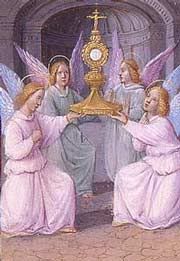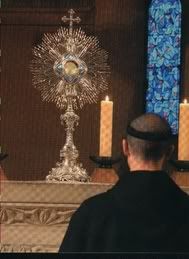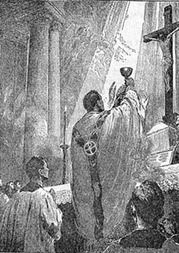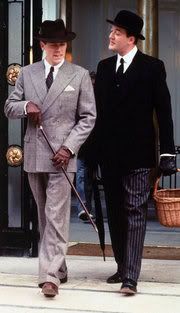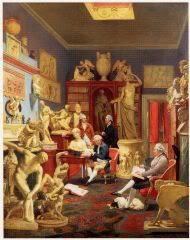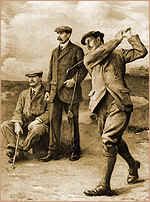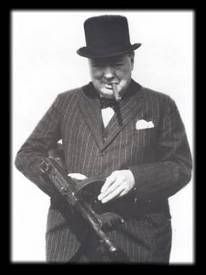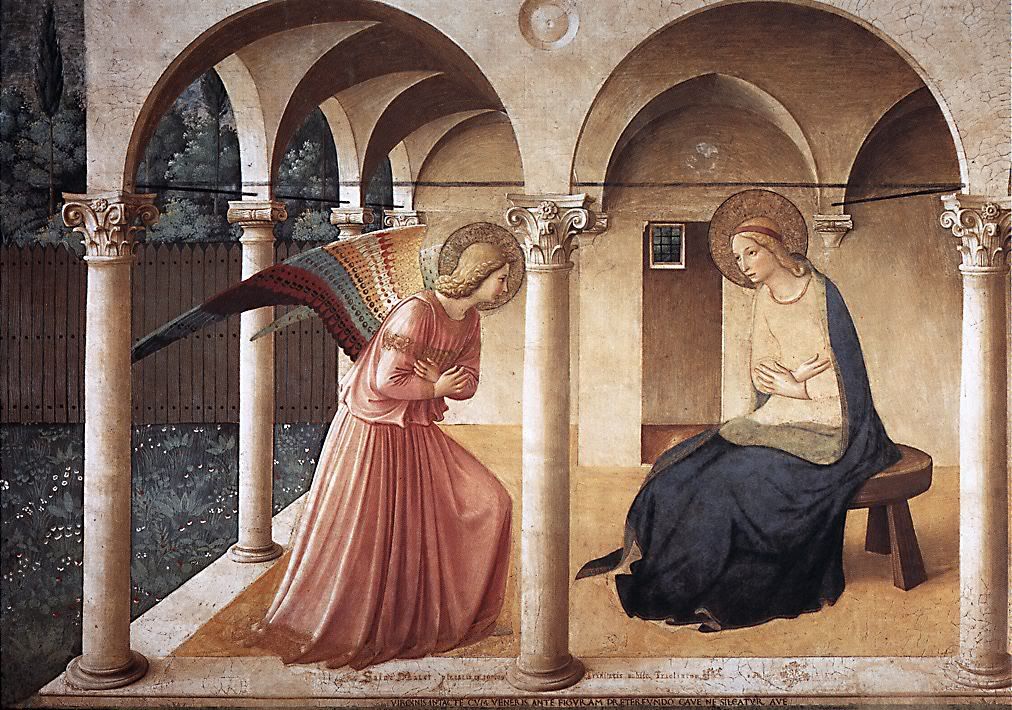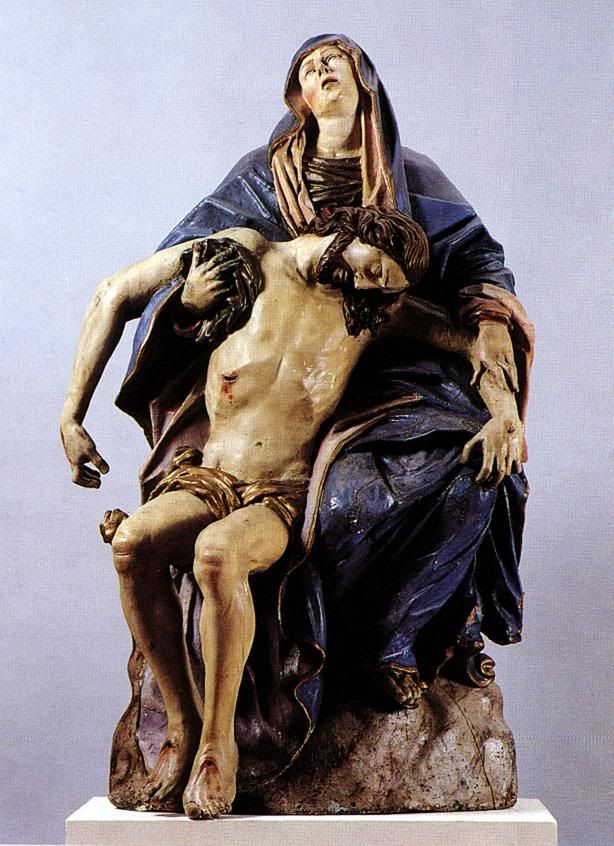Saturday, May 17, 2003
Add This One To the Al Qaeda Spring Offensive File
The targets in Casablanca included a Jewish community center, the Belgian consulate, and a Spanish restaraunt. Forty at least died in the suicide bombings.
The targets in Casablanca included a Jewish community center, the Belgian consulate, and a Spanish restaraunt. Forty at least died in the suicide bombings.
Daily Marian Reflection
From YeOldeWoburn.com:
Mary: The Sorrowing Mother
"Our Lady is there listening to the words of her Son, united to him in his suffering, when he cried out 'My God, my God, why have you forsaken me?' What could she do? She united herself fully with the redemptive love of her Son and offered to the Father her immense sorrow, which pierced her pure heart like a sharp-edged sword."
Let us offer to our Mother today:
The Mortification of keeping quiet about any pain or discomfort, any inconvenience or disappointment, uniting it with her pain as she stood by her crucified Son.
From YeOldeWoburn.com:
Mary: The Sorrowing Mother
"Our Lady is there listening to the words of her Son, united to him in his suffering, when he cried out 'My God, my God, why have you forsaken me?' What could she do? She united herself fully with the redemptive love of her Son and offered to the Father her immense sorrow, which pierced her pure heart like a sharp-edged sword."
Let us offer to our Mother today:
The Mortification of keeping quiet about any pain or discomfort, any inconvenience or disappointment, uniting it with her pain as she stood by her crucified Son.
Friday, May 16, 2003
Lots of Scandal-Related Stories Coming To the Fore Now
Is it just that the country was pre-occupied with the war and the build-up to it for so long that we stopped noticing Scandal-related stories? Was it just that, after Cardinal Law's resignation, both sides took a collective breather? Is it because the 1-year anniversary of the Dallas policy is coming up in 2-3 weeks?
Whatever the cause, there have been more Scandal-related stories in the news the last week than in the preceeding three months combined.
The Grahmann/Dallas situation continues to spin out of control, with nasty new stories about a priest who allegedly raped a nun, fathered a child on her, and has denied paternity, despite previously acknowledging it.
In the Shanley case, the Archdiocese has been given permission by a judge to go on a fishing expedition in police files pertaining to Shanely victim Greg Ford.
There is the story about the Minnesota priest who may have groped an undercover cop in a public park this week. (see below)
There is the trial of the New York priest who embezzled close to $100,000.00 to support his gay live-in lover (and may have done the same thing in the 1980s at another parish). Amy Welborn found that link.
Cardinal Maida actually did something regarding a well-known heretic. (see below)
My neighbor Domenico Bettinelli is now reporting about a group of homosexual priests who may (it may be a hoax; it certainly is odd) have written an open letter to the Bishop of Johnstown/Altoona (no paragon of good administration, if I recall recent stories correctly) demanding that he stop persecuting them, settle the lawsuits no matter what, and stop sending seminarians to such "rigid" seminaries where they learn things like Catholic orthodoxy and fidelity to the Magisterium.
If this is genuine, it is unfreakin'believable. It would also be very much out of character. The lavender mafia gets its way from the inside, through contacts, influence, friends in high places, not by public protests against those in power.
As Domenico says, the text of the letter itself is amazing (warning: someone scanned it in as a photograph. You can't copy the text for republication without reading it and re-typing). The 26 anonymous signatories complain about "Talibanic conservative clergy & laity... ." They want liberal psychiatrists to work over conservative candidates for the priesthood, in just the manner Michael Rose describes in Goodbye, Good Men, since they are too "rigid," they think, to serve the "modern" Church. I wonder if they considered that they were making part of Rose's case for him.
If this is genuine, we have met the enemy, and he is amazingly stupid.
Is it just that the country was pre-occupied with the war and the build-up to it for so long that we stopped noticing Scandal-related stories? Was it just that, after Cardinal Law's resignation, both sides took a collective breather? Is it because the 1-year anniversary of the Dallas policy is coming up in 2-3 weeks?
Whatever the cause, there have been more Scandal-related stories in the news the last week than in the preceeding three months combined.
The Grahmann/Dallas situation continues to spin out of control, with nasty new stories about a priest who allegedly raped a nun, fathered a child on her, and has denied paternity, despite previously acknowledging it.
In the Shanley case, the Archdiocese has been given permission by a judge to go on a fishing expedition in police files pertaining to Shanely victim Greg Ford.
There is the story about the Minnesota priest who may have groped an undercover cop in a public park this week. (see below)
There is the trial of the New York priest who embezzled close to $100,000.00 to support his gay live-in lover (and may have done the same thing in the 1980s at another parish). Amy Welborn found that link.
Cardinal Maida actually did something regarding a well-known heretic. (see below)
My neighbor Domenico Bettinelli is now reporting about a group of homosexual priests who may (it may be a hoax; it certainly is odd) have written an open letter to the Bishop of Johnstown/Altoona (no paragon of good administration, if I recall recent stories correctly) demanding that he stop persecuting them, settle the lawsuits no matter what, and stop sending seminarians to such "rigid" seminaries where they learn things like Catholic orthodoxy and fidelity to the Magisterium.
If this is genuine, it is unfreakin'believable. It would also be very much out of character. The lavender mafia gets its way from the inside, through contacts, influence, friends in high places, not by public protests against those in power.
As Domenico says, the text of the letter itself is amazing (warning: someone scanned it in as a photograph. You can't copy the text for republication without reading it and re-typing). The 26 anonymous signatories complain about "Talibanic conservative clergy & laity... ." They want liberal psychiatrists to work over conservative candidates for the priesthood, in just the manner Michael Rose describes in Goodbye, Good Men, since they are too "rigid," they think, to serve the "modern" Church. I wonder if they considered that they were making part of Rose's case for him.
If this is genuine, we have met the enemy, and he is amazingly stupid.
Minnesota Priest Gropes Undercover Cop In Public Park, Diocese Says It Is Not Covered By Sexual Misconduct Policy
You see, it was the priest's day off, and the cop was an adult. I haven't seen a new story like this in a while. People must think the heat is off and they can go back to normal (for them) behaviour.
The non-reaction of the diocese is a disgrace. I don't care how short they are on priests. Get the laicization process under way if the guy is found guilty or cops a plea. The Church cannot consider homosexual practices a grave sin on the one hand, and tolerate them among her priesthood. At the very least, this guy should be reassigned to a post in which he will never come into professional contact with a minor without a parent closely supervising.
Thanks to Amy Welborn for the link.
You see, it was the priest's day off, and the cop was an adult. I haven't seen a new story like this in a while. People must think the heat is off and they can go back to normal (for them) behaviour.
The non-reaction of the diocese is a disgrace. I don't care how short they are on priests. Get the laicization process under way if the guy is found guilty or cops a plea. The Church cannot consider homosexual practices a grave sin on the one hand, and tolerate them among her priesthood. At the very least, this guy should be reassigned to a post in which he will never come into professional contact with a minor without a parent closely supervising.
Thanks to Amy Welborn for the link.
Peter Vere At Catholic Light Calls Attention To Something To Praise Cardinal Maida For
Thanks to Mark Shea for the link.
For those who don't want to wade through the letters (especially the long, whiny reply by the heretic in question) here is the gist of it. A parish in Cardinal Maida's Archdiocese invited a guy named Anthony Padovono, who appears to be quite the left-wing heretic, to speak at an event being held on the parish's property. Cardinal Maida got wind of it, knew the history of this guy very well (reading the response, one gets the impression that Padovano, a defrocked priest, may have studied at Rome with Maida back in the 1960s), and orderd the pastor to cancel the event and close his parish's doors to any presentation by this guy.
Don't even go to the free speech objection. It holds no water. The Church is not a government actor, and the First Amendment only protects speech against government intrusion. Padovano has the right to believe and say whatever he wants. And the Church has as absolute a right to say "You may not say that on our property." In fact, reading this guy's CV, as summarized for the pastor by Cardinal Maida, and his own reply, one gets the impression that he likes nothing more than to insinuate that his heresies are, in fact, truly the belief of the Roman Catholic Church. So the Church has a right not just to deny him the use of her facilities, but the right to say what is and what is not authentically Catholic doctrine. In fact, it is Cardinal Maida's duty to safeguard his flock from heresy.
Cardinal Maida did his duty here. He deserves a pat on the back for this little victory. I suspect that what he will get is carping from busybodies who, in their expansive view of the value of open discussion, never grasped Richard Weaver's dictum, "ideas have consequences."
More Catholic prelates need to put their foot down against heretical speakers making use of the facilities of the local parishes to spread their error.
Thanks to Mark Shea for the link.
For those who don't want to wade through the letters (especially the long, whiny reply by the heretic in question) here is the gist of it. A parish in Cardinal Maida's Archdiocese invited a guy named Anthony Padovono, who appears to be quite the left-wing heretic, to speak at an event being held on the parish's property. Cardinal Maida got wind of it, knew the history of this guy very well (reading the response, one gets the impression that Padovano, a defrocked priest, may have studied at Rome with Maida back in the 1960s), and orderd the pastor to cancel the event and close his parish's doors to any presentation by this guy.
Don't even go to the free speech objection. It holds no water. The Church is not a government actor, and the First Amendment only protects speech against government intrusion. Padovano has the right to believe and say whatever he wants. And the Church has as absolute a right to say "You may not say that on our property." In fact, reading this guy's CV, as summarized for the pastor by Cardinal Maida, and his own reply, one gets the impression that he likes nothing more than to insinuate that his heresies are, in fact, truly the belief of the Roman Catholic Church. So the Church has a right not just to deny him the use of her facilities, but the right to say what is and what is not authentically Catholic doctrine. In fact, it is Cardinal Maida's duty to safeguard his flock from heresy.
Cardinal Maida did his duty here. He deserves a pat on the back for this little victory. I suspect that what he will get is carping from busybodies who, in their expansive view of the value of open discussion, never grasped Richard Weaver's dictum, "ideas have consequences."
More Catholic prelates need to put their foot down against heretical speakers making use of the facilities of the local parishes to spread their error.
Daily Marian Reflection
From YeOldeWoburn.com:
Mary: At The Foot Of The Cross
"We find her on Calvary, at the foot of the cross, praying. This is nothing new for Mary. She has always acted like this, in fulfilling her duties and looking after her home. As she wept about the things on earth, she kept her attention on God."
Let us offer to our Mother today:
An Act of contrition, said many times, asking her to offer our sorrow for our sins to Jesus crucified.
From YeOldeWoburn.com:
Mary: At The Foot Of The Cross
"We find her on Calvary, at the foot of the cross, praying. This is nothing new for Mary. She has always acted like this, in fulfilling her duties and looking after her home. As she wept about the things on earth, she kept her attention on God."
Let us offer to our Mother today:
An Act of contrition, said many times, asking her to offer our sorrow for our sins to Jesus crucified.
Thursday, May 15, 2003
Oh Man, Some of This Stuff Is Funny
The Top 10 Things I Hate About Star Trek. Thanks to Jonah Goldberg for the link.
The Top 10 Things I Hate About Star Trek. Thanks to Jonah Goldberg for the link.
Ohio Retired Priest Cops Plea In Case Involving Pimping for Underage Male Prostitute
The good news is that this guy is out of the priesthood. He was the only priest indicted in Ohio. Some places were not as heavily hit as Boston was by the pervert priest scandal.
The good news is that this guy is out of the priesthood. He was the only priest indicted in Ohio. Some places were not as heavily hit as Boston was by the pervert priest scandal.
The Oreo Suit Has Been Dropped
The attorney who filed it admits that it was all a publicity stunt to gain notice for the cause he espouses. I think sanctions are in order for using the court system in this manner, though I not sure what California law provides in this regard. If I were a judge, I would surely consider a suspension, if the remedy was available to me.
The attorney who filed it admits that it was all a publicity stunt to gain notice for the cause he espouses. I think sanctions are in order for using the court system in this manner, though I not sure what California law provides in this regard. If I were a judge, I would surely consider a suspension, if the remedy was available to me.
Requiescat In Pace
Actor Robert Stack died yesterday at his home at the age of 84. To be honest, I did not see much that he was in. As a kid, I watched B&W reruns of the Untouchables, in which he played crusading G-Man Eliot Ness, probably the defining role of his career. In 1980, he parodied his tough-guy image in a comic role in Airplane!, one of my favorite comedies. I did not see him in much else. I never watched his other big series, Unsolved Mysteries. He was a younger part of a long-gone generation of movie actors. He was a drinking buddy of Clark Gable and Spencer Tracy. He and his wife were married in 1956, and had two children. Requiescat in pace.
Actor Robert Stack died yesterday at his home at the age of 84. To be honest, I did not see much that he was in. As a kid, I watched B&W reruns of the Untouchables, in which he played crusading G-Man Eliot Ness, probably the defining role of his career. In 1980, he parodied his tough-guy image in a comic role in Airplane!, one of my favorite comedies. I did not see him in much else. I never watched his other big series, Unsolved Mysteries. He was a younger part of a long-gone generation of movie actors. He was a drinking buddy of Clark Gable and Spencer Tracy. He and his wife were married in 1956, and had two children. Requiescat in pace.
Only Monsignor To Sign Letter Calling for Law's Resignation Resigns
The story of Monsignor Groden is sort of complicated. He was not just the pastor of St. Cecilia's parish in the Back Bay. He was also in charge of the Archdiocese's Planning Office For Urban Affairs. In the latter capacity, he was sued by a developer who claimed he had cheated him in a realty transaction. The Archdiocese settled the matter for $2.7 million. The Archdiocese has been unhappy with certain aspects of the Monsignor's extensive financial dealings. He was also seen as a force independent of the Archdiocese, someone who, by his contacts had developed a significant power base of his own based on his own expertise and contacts.
Just look at the big-time liberals quoted in the Globe article as coming to Groden's defense. Rosaria Salerno, who was in the Univesity Chaplaincy Office at B.C. during my student days, and never met a Sandinista she didn't love. TIp O'Neill's son, the former Lieutenant Governor under the early Dukakis Administration. And then there is Micho Spring, a consistent liberal commentator when she used to appear on the Boston public affairs' show Five On Five (I think she was appointed deputy mayor by Kevin White: she is a two-fer, Hispanic and a woman). If a guy has friends like these, I need to know nothing more to know that he is an enemy.
I have also heard stories of pastors with parish-owned realty trying to turn to him for advice on what to do with it. When the calls were never returned, and the letters never answered, you knew it was Monsignor Groden.
Good for Bishop Lennon. Now he should take the heads of Fathers Cuenin and Bullock. That is an important part of cleaning up the mess that is the Archdiocese of Boston.
The story of Monsignor Groden is sort of complicated. He was not just the pastor of St. Cecilia's parish in the Back Bay. He was also in charge of the Archdiocese's Planning Office For Urban Affairs. In the latter capacity, he was sued by a developer who claimed he had cheated him in a realty transaction. The Archdiocese settled the matter for $2.7 million. The Archdiocese has been unhappy with certain aspects of the Monsignor's extensive financial dealings. He was also seen as a force independent of the Archdiocese, someone who, by his contacts had developed a significant power base of his own based on his own expertise and contacts.
Just look at the big-time liberals quoted in the Globe article as coming to Groden's defense. Rosaria Salerno, who was in the Univesity Chaplaincy Office at B.C. during my student days, and never met a Sandinista she didn't love. TIp O'Neill's son, the former Lieutenant Governor under the early Dukakis Administration. And then there is Micho Spring, a consistent liberal commentator when she used to appear on the Boston public affairs' show Five On Five (I think she was appointed deputy mayor by Kevin White: she is a two-fer, Hispanic and a woman). If a guy has friends like these, I need to know nothing more to know that he is an enemy.
I have also heard stories of pastors with parish-owned realty trying to turn to him for advice on what to do with it. When the calls were never returned, and the letters never answered, you knew it was Monsignor Groden.
Good for Bishop Lennon. Now he should take the heads of Fathers Cuenin and Bullock. That is an important part of cleaning up the mess that is the Archdiocese of Boston.
Space, Politics, & Single Malt Whiskey (sic)
I came across this interesting blog this morning. I was only interested in the single malt discussion, so I don't know if I would recommend the whole content.
I've been drinking single malts, liqueurs, and good ports and sherries since college (I never liked beer). One of the most extravagant things I ever did was to buy a case of Offley Baron de Forrester 1955 when I graduated from college. My collection (and that is what it mostly is, since I am pretty abstemious in my personal habits) contains Drambuie, Chambord, Amaretto di Saronno, Cointreau, Grand Marnier, Kirsch, Galliano, with the odd bottle of Tanqueray, Captain Morgan, Courvoisier, Savory & James Cream Sherry, Malmsey, and a few bottles of wine to serve with special dinners.
But it is the single malts that I treasure, even if they are not always my tipple of choice. I notice that Patheticearthlings has a list of questions they ask celebrities about their single malt consumption. They are not likely to ask me to take it, but here is my own version with my answers anyway.
What single malts do you now have in the house? Glenlivet 12 (minus 2 drams), Glenlivet 18 (minus 3 drams), Laphroig (minus 1 dram), Oban (unopened).
How often do you have a dram ? About once a month, except during Lent.
How do you take your dram? Two fingers' height in an old fashioned glass, straight up.
How were you introduced to single malts? I hung around with a crowd of conservative aesthetes in college. We had a grand eccentric, some B-school frat boy types (though at BC we had no frats), so I decided to become the expert on expensive alcohol. I read up on the subject, and started sampling as soon as I turned 20 (the legal age back then).
When do you prefer your dram? After dinner.
What effect does it have on you? A mild buzz.
What single malt do you prefer with a cigar? That depends on the cigar. Something with a strong flavor requires an assertive malt, like the strong, peaty kick of Laphroig. A mild cigar, like a Dunhill Peravia or a Fonseca 10-10 takes Glenlivet nicely. Though, my preferred drink with a cigar isn't a single malt at all, but a liqueur like Cointreau, Drambuie, or Grand Marnier. I am also very accustomed to the convention of port with cigars, from years of mess dinners.
Most interesting single malt story? A few years ago, my re-enactment regiment was spending a weekend at a colonial-era fort in the company of Indian re-enactors. One of the gifts we would provide them was firewater. I went out and bought two bottles of this stuff that you might call whisky that came in large, plastic bottles for $10.00 each. It was, at least, bottled in Scotland. We transferred them to oak casks. The evening after the event, some of the Indians came up to us and profusely thanked us for it. They said it was the best single malt they had ever had, and that we really went beyond the call of civility in providing them as a gift with such wonderful whisky! Maybe it was the week in the oak casks. Then again, they had been helping themselves to my Black Forest Trifle, loaded with Kirsch and Creme de Cacao at the time, too. Perhaps it had an effect on their taste buds. Nevertheless, that regiment has had good relations with the Indians ever since.
I came across this interesting blog this morning. I was only interested in the single malt discussion, so I don't know if I would recommend the whole content.
I've been drinking single malts, liqueurs, and good ports and sherries since college (I never liked beer). One of the most extravagant things I ever did was to buy a case of Offley Baron de Forrester 1955 when I graduated from college. My collection (and that is what it mostly is, since I am pretty abstemious in my personal habits) contains Drambuie, Chambord, Amaretto di Saronno, Cointreau, Grand Marnier, Kirsch, Galliano, with the odd bottle of Tanqueray, Captain Morgan, Courvoisier, Savory & James Cream Sherry, Malmsey, and a few bottles of wine to serve with special dinners.
But it is the single malts that I treasure, even if they are not always my tipple of choice. I notice that Patheticearthlings has a list of questions they ask celebrities about their single malt consumption. They are not likely to ask me to take it, but here is my own version with my answers anyway.
What single malts do you now have in the house? Glenlivet 12 (minus 2 drams), Glenlivet 18 (minus 3 drams), Laphroig (minus 1 dram), Oban (unopened).
How often do you have a dram ? About once a month, except during Lent.
How do you take your dram? Two fingers' height in an old fashioned glass, straight up.
How were you introduced to single malts? I hung around with a crowd of conservative aesthetes in college. We had a grand eccentric, some B-school frat boy types (though at BC we had no frats), so I decided to become the expert on expensive alcohol. I read up on the subject, and started sampling as soon as I turned 20 (the legal age back then).
When do you prefer your dram? After dinner.
What effect does it have on you? A mild buzz.
What single malt do you prefer with a cigar? That depends on the cigar. Something with a strong flavor requires an assertive malt, like the strong, peaty kick of Laphroig. A mild cigar, like a Dunhill Peravia or a Fonseca 10-10 takes Glenlivet nicely. Though, my preferred drink with a cigar isn't a single malt at all, but a liqueur like Cointreau, Drambuie, or Grand Marnier. I am also very accustomed to the convention of port with cigars, from years of mess dinners.
Most interesting single malt story? A few years ago, my re-enactment regiment was spending a weekend at a colonial-era fort in the company of Indian re-enactors. One of the gifts we would provide them was firewater. I went out and bought two bottles of this stuff that you might call whisky that came in large, plastic bottles for $10.00 each. It was, at least, bottled in Scotland. We transferred them to oak casks. The evening after the event, some of the Indians came up to us and profusely thanked us for it. They said it was the best single malt they had ever had, and that we really went beyond the call of civility in providing them as a gift with such wonderful whisky! Maybe it was the week in the oak casks. Then again, they had been helping themselves to my Black Forest Trifle, loaded with Kirsch and Creme de Cacao at the time, too. Perhaps it had an effect on their taste buds. Nevertheless, that regiment has had good relations with the Indians ever since.
Daily Marian Reflection
From YeOldeWoburn.com:
Mary: At Cana
"In the Gospel, St. John has recorded a wonderful phrase of Our Lady. At the wedding of Cana she turned to the waiters and said: 'Do whatever he tells you.' That is what it is all about - getting people to face Jesus and ask him: 'Lord, what do you want me to do?'"
Let us offer to our Mother today:
Prompt obedience, when we are called or asked to do some errand or some act of service.
From YeOldeWoburn.com:
Mary: At Cana
"In the Gospel, St. John has recorded a wonderful phrase of Our Lady. At the wedding of Cana she turned to the waiters and said: 'Do whatever he tells you.' That is what it is all about - getting people to face Jesus and ask him: 'Lord, what do you want me to do?'"
Let us offer to our Mother today:
Prompt obedience, when we are called or asked to do some errand or some act of service.
Wednesday, May 14, 2003
Very Interesting Discussion Going On
If the topic of liturgical reform is of interest to you, you should check out the debate over at Amy Welborn's reactivated In Between Naps (second blog from the top at this writing, Amy doesn't have whatever is needed to link directly to individual blogs anymore). The discussion, inspired by Cardinal Arinze's comments of yesterday, has been wide-ranging on the issue of dissatisfaction with the current state of Catholic liturgy. Some really great points have been made, such as, what would a Latin Mass feel like with congregants dressed casually, no chapel veils, with altar girls, with Communion in the hand and standing, with the modern calendar of saints. Lots of good questions.
Surprisingly, there are a few people who like the liturgy as it is. But the majority seems to be praying that Cardinal Arinze's sentiments will become not just Vatican policy, but the law of the land and of the parish. It will take a lot of praying. But persistence often pays off, and having the home office of the Church on your side can't hurt.
If the topic of liturgical reform is of interest to you, you should check out the debate over at Amy Welborn's reactivated In Between Naps (second blog from the top at this writing, Amy doesn't have whatever is needed to link directly to individual blogs anymore). The discussion, inspired by Cardinal Arinze's comments of yesterday, has been wide-ranging on the issue of dissatisfaction with the current state of Catholic liturgy. Some really great points have been made, such as, what would a Latin Mass feel like with congregants dressed casually, no chapel veils, with altar girls, with Communion in the hand and standing, with the modern calendar of saints. Lots of good questions.
Surprisingly, there are a few people who like the liturgy as it is. But the majority seems to be praying that Cardinal Arinze's sentiments will become not just Vatican policy, but the law of the land and of the parish. It will take a lot of praying. But persistence often pays off, and having the home office of the Church on your side can't hurt.
The Mass Grave Of Saddam's Victims May Contain 11,000 Remains
Many of the victims of Saddam's terror buried there were women. Some were buried alive. This finding in and of itself justifies our ouster of that regime.
Many of the victims of Saddam's terror buried there were women. Some were buried alive. This finding in and of itself justifies our ouster of that regime.
Putting the Pieces Together
In the last week, there is mounting evidence that al Qaeda is growing more active. In fact, the events of the last week fit into a pattern. The car bombs in Saudi Arabia that killed 34, including 8 American civilians, came a day before a suicide bomb attack in Chechnya (al Qaeda is known to be very active in Chechnya). Late last week, the Moro Liberation Front (which is affiliated with al Qaeda) perpetrated at least 2 bombings in the Philippines. Last night, there was bombing at a courthouse in Yemen where al Qaeda members had been tried and convicted. A group of European tourists were kidnapped by al Qaeda-linked terrorists, but about half were released in a raid by Algerian commandos. Two US soldiers in Iraq were shot last week. There was a grenade or rocket attack on US troops in Afghanistan very early last week.
Al Qaeda is launching a sprng offensive. I don't see how you can come to any other conclusion.
The means, car bombs, grenade attacks, shootings, indicate that the new leadership in al Qaeda lacks the means or the opportunity to use more devastating tactics or weapons. The locations of the attacks, Saudi Arabia, Algeria, Yemen, Afghanistan, Chechnya, the Philippines, indicate that al Qaeda's reach is being limited to its home turf.
But they are actively seeking an opportunity to launch a devastating strike against the US. The coordination of attacks across the Moslem world indicates increased activity, the availability of funds, and leadership and coordination.
Do not be shocked if the national alert level is increased to orange again soon.
In the last week, there is mounting evidence that al Qaeda is growing more active. In fact, the events of the last week fit into a pattern. The car bombs in Saudi Arabia that killed 34, including 8 American civilians, came a day before a suicide bomb attack in Chechnya (al Qaeda is known to be very active in Chechnya). Late last week, the Moro Liberation Front (which is affiliated with al Qaeda) perpetrated at least 2 bombings in the Philippines. Last night, there was bombing at a courthouse in Yemen where al Qaeda members had been tried and convicted. A group of European tourists were kidnapped by al Qaeda-linked terrorists, but about half were released in a raid by Algerian commandos. Two US soldiers in Iraq were shot last week. There was a grenade or rocket attack on US troops in Afghanistan very early last week.
Al Qaeda is launching a sprng offensive. I don't see how you can come to any other conclusion.
The means, car bombs, grenade attacks, shootings, indicate that the new leadership in al Qaeda lacks the means or the opportunity to use more devastating tactics or weapons. The locations of the attacks, Saudi Arabia, Algeria, Yemen, Afghanistan, Chechnya, the Philippines, indicate that al Qaeda's reach is being limited to its home turf.
But they are actively seeking an opportunity to launch a devastating strike against the US. The coordination of attacks across the Moslem world indicates increased activity, the availability of funds, and leadership and coordination.
Do not be shocked if the national alert level is increased to orange again soon.
The Sad Demise of the UMass Minuteman
Chris Weinkopf, a former Bay State native writing for FrontPage Magazine, justly castigates UMass for considering replacing the Minuteman as the symbol of the public university's athletic teams. I could not agree more with his sentiments.
And over at Ad Orientem, Mark Sullivan has some suggestions for a replacement, and has assembled some links on the topic. I have to agree with a point both Mark and Weinkopf make. If the UMass teams won more games, their merchandise would sell better.
Chris Weinkopf, a former Bay State native writing for FrontPage Magazine, justly castigates UMass for considering replacing the Minuteman as the symbol of the public university's athletic teams. I could not agree more with his sentiments.
And over at Ad Orientem, Mark Sullivan has some suggestions for a replacement, and has assembled some links on the topic. I have to agree with a point both Mark and Weinkopf make. If the UMass teams won more games, their merchandise would sell better.
Former Archbishop of Canterbury Suggests Anglican Bishops Make Ad Limina Visits To The Pope
Lord Carey's idea, proposed at a Lateran Conference on John Paul's papacy, is interesting. However, given the ordination of women and openly homosexual men, as well as married and divorced men, in the Anglican communion, I don't see how that is possible. The Holy Father accepting the visits of bishops of Church of England (or Ireland, or Scotland, or the Episcopal Church of the US) would be a de facto endorsement of the unjustified and improper ordinations carried out by that communion.
He can, of course, meet with them as leaders of Christian communities not in communion with him. But an Ad Limina visit implies that they are coming to the Holy Father for instructions on how to run their dioceses. What other first advice can a Roman pontiff give an Anglican bishop than to stop ordaining the above categories of people, and defrock the ones already ordained?
And then, there are the doctrinal issues that divide the Anglican communion from Rome...
Lord Carey's idea, proposed at a Lateran Conference on John Paul's papacy, is interesting. However, given the ordination of women and openly homosexual men, as well as married and divorced men, in the Anglican communion, I don't see how that is possible. The Holy Father accepting the visits of bishops of Church of England (or Ireland, or Scotland, or the Episcopal Church of the US) would be a de facto endorsement of the unjustified and improper ordinations carried out by that communion.
He can, of course, meet with them as leaders of Christian communities not in communion with him. But an Ad Limina visit implies that they are coming to the Holy Father for instructions on how to run their dioceses. What other first advice can a Roman pontiff give an Anglican bishop than to stop ordaining the above categories of people, and defrock the ones already ordained?
And then, there are the doctrinal issues that divide the Anglican communion from Rome...
Daily Marian Reflection
From YeOldeWoburn.com:
Mary: Losing And Finding The Child Jesus
"The mother of God, who looked for her Son so anxiously when he was lost (through no fault of her own) and experienced such great joy in finding him, will help us retrace our steps and put right whatever may be necessary when, because of our carelessness or our sins, we have been unable to recognize Christ. With her help, we will know the happiness of holding him in our arms once more and telling him we will never lose him again."
Let us offer to our Mother today:
A good, sincere, sorrowful confession of our sins and failures, in the sacrament of Penance.
From YeOldeWoburn.com:
Mary: Losing And Finding The Child Jesus
"The mother of God, who looked for her Son so anxiously when he was lost (through no fault of her own) and experienced such great joy in finding him, will help us retrace our steps and put right whatever may be necessary when, because of our carelessness or our sins, we have been unable to recognize Christ. With her help, we will know the happiness of holding him in our arms once more and telling him we will never lose him again."
Let us offer to our Mother today:
A good, sincere, sorrowful confession of our sins and failures, in the sacrament of Penance.
Tuesday, May 13, 2003
"The Do-It-Yourself Mass Is Ended"
Thanks to Domenico Bettinelli for the link.
The words above are those of Cardinal Arinze, head of the Congregation for Divine Worship, not a man given to loose talk or irresponsible statements. A major disciplinary document, mentioned in the Holy Father's recent encyclical on the Eucharitst is in draft form, and will be published this fall.
According to Cardinal Arinze, the document will strictly regulate the manner in which the Mass is to be said, and sanction every parish in the world to have one Tridentine Latin Mass per weekend. Wow.
As Domenico points out, the proof will be in how it is enforced at the diocese/parish level. Will the USCCB staff work to make it a dead letter? Will individual bishops undermine its implementation? If the Holy Father died tomorrow, would the project be shelved permanently? Will it be ignored just because a new Pope might take office in a year or two?
One recalls the fate of the 1962 disciplinary document on not ordaining homosexuals. Once the Second Vatican council took place, it was disregarded as "pre-Vatican II," though not a single line in the documents of Vatican II repealed it.
Pray that this reform of the reform is successful. The Novus Ordo and the Tridentine Rite can co-exist in the same parish. As long as both are said with reverence and dignity. I just wish that Cardinal Arinze's office would hurry up and get the document into final form and released on a quicker timetable than is currently contemplated. Make it a fait accompli, rather than something that can be pushed aside by a successor pontificate. I'd also be happier seeing Cardinal Arinze and Cardinal Ratzinger enforcing it than almost any possible successors (except maybe Cardinal Shoenborn, who may succeed Ratzinger).
Thanks to Domenico Bettinelli for the link.
The words above are those of Cardinal Arinze, head of the Congregation for Divine Worship, not a man given to loose talk or irresponsible statements. A major disciplinary document, mentioned in the Holy Father's recent encyclical on the Eucharitst is in draft form, and will be published this fall.
According to Cardinal Arinze, the document will strictly regulate the manner in which the Mass is to be said, and sanction every parish in the world to have one Tridentine Latin Mass per weekend. Wow.
As Domenico points out, the proof will be in how it is enforced at the diocese/parish level. Will the USCCB staff work to make it a dead letter? Will individual bishops undermine its implementation? If the Holy Father died tomorrow, would the project be shelved permanently? Will it be ignored just because a new Pope might take office in a year or two?
One recalls the fate of the 1962 disciplinary document on not ordaining homosexuals. Once the Second Vatican council took place, it was disregarded as "pre-Vatican II," though not a single line in the documents of Vatican II repealed it.
Pray that this reform of the reform is successful. The Novus Ordo and the Tridentine Rite can co-exist in the same parish. As long as both are said with reverence and dignity. I just wish that Cardinal Arinze's office would hurry up and get the document into final form and released on a quicker timetable than is currently contemplated. Make it a fait accompli, rather than something that can be pushed aside by a successor pontificate. I'd also be happier seeing Cardinal Arinze and Cardinal Ratzinger enforcing it than almost any possible successors (except maybe Cardinal Shoenborn, who may succeed Ratzinger).
The Passion To Be Released Next Year
Mel Gibson has wrapped up filming and is planning to release The Passion in time for Lent, 2004.
Mel Gibson has wrapped up filming and is planning to release The Passion in time for Lent, 2004.
Horrible Desecration At a Pius X Society Chapel On Long Island
Say what you want about "lidless eye" types. But the Vatican is currently negotiating in some form with the Pius X Society on the universal indult. And the Pius X Society, as far as I understand it, recognizes the legitimacy and authority of the Holy Father (though not Vatican II). Catholics of all stripes should be saddened by this desecration of the Eucharist, and pray for the recovery of this community.
Say what you want about "lidless eye" types. But the Vatican is currently negotiating in some form with the Pius X Society on the universal indult. And the Pius X Society, as far as I understand it, recognizes the legitimacy and authority of the Holy Father (though not Vatican II). Catholics of all stripes should be saddened by this desecration of the Eucharist, and pray for the recovery of this community.
Democrat Legislators From Texas Make Themselves Scarce
But for quorum rules (and that is what this is all about) would that it would happen here, permanently.
But for quorum rules (and that is what this is all about) would that it would happen here, permanently.
Now They Are Coming for Our Oreos
Memo to Stephen Joseph: I like my Oreos better than I like you. I am sure 99.9% of the US population agrees with me here.
Joseph or my Oreos? No contest. Oreos win hand down.
Hey Stephen Joseph, don't fiddle with the Oreo middle!
Memo to Stephen Joseph: I like my Oreos better than I like you. I am sure 99.9% of the US population agrees with me here.
Joseph or my Oreos? No contest. Oreos win hand down.
Hey Stephen Joseph, don't fiddle with the Oreo middle!
Books Worth A Few Minutes' Attention At A Time
There are books that you read with great attention, studying the writing style of the author, trying to pick up every nuance of plot, character development, or every rhetorical flourish. I just started such a book last night, Hilaire Belloc's Europe and the Faith, which is a book almost guaranteed to have you lamenting the decline of the concept of Christendom before you reach page 20.
But that is not the type of book we are discussing today. We are addressing the topic of books that some may display on their coffee tables, books that one glances through, perhaps reading the caption of some illustrations, or a few paragraphs or pages at a time. We are, in short, talking about the shelf outside the bathroom.
The shelf outside the bathroom needs some variety. One is not often in the mood for the same book time after time (though maybe again and again). Sometimes one wants to read some poetry or acclaimed prose. Sometimes one just wants to look at pictures, or have a laugh. Generally, one wants to take in information in little snippets. And there is something comforting in re-reading there things one has read many times before, that do not require one's full attention.
Some people take magazines in with them, and the topic of what dead tree publications a household takes in is probably worth a blog by itself. Catalogs are classic bathroom reading. Here J.Press, Brooks Brothers, The Andover Shop, Penzey's Spices, Burpee Seeds, L.L. Bean, Ignatius Press, Jos. A. Bank, The Vermont Country Store, Britannia Videos, Harry & David's and Zabar's are often found near the bathroom.
But there must be more to one's reading while on the toilet. One ought to have a shelf of books (that might well have duplicate copies at other parts of one's library) near the entrance to the bathroom. It is much more convenient than hunting through the house for just the right book when the urge strikes. Many a household has heard an exchange like the one that follows.
"I thought you were going to the bathroom."
"I will, but I need to find something to read first."
To advance human comfort, here is my list of suggestions for those assembling a shelf outside the bathroom.
The Monks of Durham by Anne Boyd
This illustrated guide to the monastic life of the monks of Durham Cathedral Priory was required reading in my Medieval Europe class in college. The books is really for children, but is lavishly illustrated with photos and period drawings and details from illuminated manuscripts. And the text gives some idea of the daily life of a monk of the 14th or 15th century.
The Colonial Williamsburg Catalog
This isn't your average catalog. It is bound in hardcover and costs $30.00 (probably more now, I bought it ten years ago). It has helpful text on 18th century interior decorating, furniture, wallpaper, and accesories. The furniture is impossibly expensive (want to buy a reproduction 18th century chest-on-chest for $50,000.00?) but lovely to look at. The price list comes seperately (and is updated, and scaled up, frequently).
The Book of Virtues & The Moral Compass by William J. Bennett
These two books contain a treasure trove of short readings that are designed in inculcate proper values in young people. Whatever Bennett does with the money from his sales, he did a fine job tailoring the readings to the needs of the nation. And these books, though they are quite thick hardcovers, can often be found on remainder for $5 each. We have copies for bathroom reading, in the literature section in the living room, and in the conservative books wall here in the study.
Four Books of Architecture by Andrea Palladio
This is the classic work that inspired generations of European and American architects. It is based on Palladio's study of Roman ruins. Dover offers a large folio-sized paperback for under $20.00. It is a delight to lose yourself in Palladio's line drawings, to guess what 17th, 18th, or 19th century building was inspired by which Palladio study. A careful study of this book is an education in timeless good taste. Just dipping into it for a few minutes is great fun.
The King's English by Kingsley Amis
The late best-selling author was a defender of traditional English prose. His, I think final, book on writing, he organized as an alphabetical compendium of his complaints about current usage. You can read as much or as little as you like. It makes no sense to read it though from cover to cover. His mini-essay on the Disappearance of Latin is very much worth the ten minutres it will take to read.
Republican Party Reptile by P.J. O'Rourke
Not for children or the easily offended. But these funny essays that appeared in various publications in the 1970s and early 1980s still get a howl out of me once in a while. Whether the topic is safety Nazis, mens' hats, or the threat that bicycle riders pose to civilization, O'Rourke is a hoot.
Gainsborough by Nicola Kalinsky
Sir Joshua Reynold's fans may dispute me on this, but Gainsborough holds a unique place in my esteem as the best 18th century English artist. His The Morning Walk is perhaps the most beautiful joint portrait of a husband and wife of its period. Kalinsky's folio-sized book provides a full page painting by Gainsborough, and a few paragraphs of explanation opposite it. The book is, unfortunately, not comprehensive, and the descriptions are not detailed enough. But if you want to sample Gainsborough's works, this is the book for you.
The Most Beautiful Villages of Ireland by Christopher Fitz-Simon
This is a coffee table book, but it works equally well for the bathroom. With Makem & Clancy on the CD player, a dish of Champ inside you, and a glass of an amber-colored beverage in your hand, this is like taking a short vacation to the Aulde Sod.
Young Men In Spats by P.G. Wodehouse
This is a collection of Wodehouse stories about the members of the Drones Club. Freddie Widgeon, Gussie Fink-Nottle, and Barmy Fotheringay-Phips are all featured. Lose yourself for a few minutes in the narration of Crumpets and Eggs as they recount the adventures of London's most eligible, and negligible bachelors of 1924.
The Church Visible: The Ceremonial Life and Protocol of the Roman Catholic Church by James-Charles Noonan, Jr.
What should a cardinal wear for a meeting or a papal audience? What is the uniform of the Swiss Guard like? What does a Knight of Malta wear on formal occasions? This is a great source of information for all those things about the Church you never wanted to know. Lots of color photos.
Country Estates of Old Danvers by Charles S. Tapley
Yes, Danvers used to be a place where the prominent summered. General Thomas Gage, Elias Hasket Derby, Timothy Pickering, and John Greenleaf Whittier were among the town's part-time residents. Tapley, who in real life founded the Hastings-Tapley Insurance Agencies, was an amatuer local historian. He wrote a page or two on some of the architecturally or historically significant houses of the town, and added a photo or two of each. One of the featured buildings is part of my alma mater, Saint John's Prep.
The Quotable Paul Johnson by Paul Johnson
Johnson is the best non-fiction prose stylist in the English language today. As a journalist and historian, he has contributed some of the late 20th century's best sentences and paragraphs. He has a gift for the quip that would not shame Samuel Johnson or G.K. Chesterton. Whether the topic is Ireland, the Catholic Church, Franco, Margaret Thatcher, John F. Kennedy, or using a typewriter, Johnson's prose is highly readable, and quotable. That is why this one volume compendium arranged alphabetically by topic is essential bathroom reading.
Poor Richard's Almanac by Benjamin Franklin and illustrated by Norman Rockwell
What an all-American combination! The timeless prose of Franklin on getting on and getting ahead through prudence, frugality, and hard work, combined with illustrations (both color plates and line illustrations) by the great American artist of the 20th century, Norman Rockwell. Each year of Poor Richard's Almanac's publication is represented, with the full text. And since each year was published as a pamphlet, you can read a year's edition in ten minutes, making it perfect for use on the shelf outside the bathroom.
Military Dress of the Peninsular War by Martin Windrow & Gerry Embleton
This illustrated guide to how the French, English, Spanish and Portugese troops who fought in Iberia betwen 1808-1814 were uniformed is wonderful. Martin Windrow provides the text, and Gerry Embleton the illustrations. Yes, this is for those with specialized interests.
The Cigar Companion: A Connoisseur's Guide by Anwar Bati & Simon Chase
Want to know about the length and ring gauge of most of the major varieties of cigar? Want to read a little bit about each brand? Ever wonder whether a Fonseca 10-10 is milder than a Santa Damiani Seleccion No. 300? If you said yes to any of the above, this is a good book to station on the shelf outside the bathroom.
The Countryman's Year by Haydn Pearson
For many years in the 1940s and 1950s, Pearson's short essays on rural life in New England appeared in the Boston Herald and the New York Times. This collection features about 12 per month, and ranges from the joys of picking wild blackberries to walking in the autumn. Pearson was a keen observer of New England's natural history and seasonal patterns, and old enough to remember the late 19th century with its travelling tinkers, dirt roads, horse-drawn buggies, and general stores. It is a joy to read his lamentations on the use of parsley on dinner plates and his prescription for eating pie (start with the crust end, so that the last bite is mostly filling) as well as his praise for sweet cider, Indian pudding, red barns, covered bridges, and apple picking. None of the essays is more than 6 short paragraphs. I usually read a months' worth at the start of each month. Pearson's writings are a charming introduction to rural New England life of 50-100 years ago. It would be nice to see new editions of his work published.
The Book of Catholic Customs and Traditions by Ronda De Sola Chervin & Carla Conley
This is one of those books designed to provide a guide for the family trying to raise its children in a traditional Catholic atmosphere. It is organized chronologically along the Church year (starting with Advent), and discusses national customs for each of the major feasts of the Church. There is also an alphabetical listing of devotional practices not associated with any particular feast day. It is a sad testimony against the World War II and Baby Boomer generations that people need how-to guides for this.
A Sea of Words: A Lexicon & Companion For Patrick O'Brian's Seafaring Tales by Dean King, et al.
Don't know a quarterdeck from an orlop? Always wondered who Admiral Saumarez was? Well Dean King has done those who want to read and enjoy Patrick O'Brian's Aubrey/Maturin novels a great service by providing a guide. Many readers are deterred by O'Brian's fluent use of 18th century medical, sailing and navigational, culinary, and political and military terms. King guides us through the jargon of the 18th century Royal Navy and medical profession that O'Brian had mastered. The bulk of the book is an alphabetical listing of the specialized terms found in the 20 novels of the series. He translates foreign words and expressions used by O'Brian, and gives a brief sketch of historical personages who appear in the novels. Invaluable for O'Brian fans.
The Essential Calvin & Hobbes by Bill Watterson
The nine year-old boy in all of us comes roaring to life in this collection of Watterson's cartoons. I went through a phase of reading Calvin & Hobbes every day some years ago, and still miss new strips. Don't drink milk while reading these (it could come out your nose, and that would be gross). Better to read Calvin in the bathroom, while you are not attempting to digest something.
The Prince by Niccolo Machiavelli
This is the essential guide for understanding the relations between states, like it or not. If you are not well versed in it, you can be sure that your national adversaries are. It is short, and arranged in short chapters, which makes it suitable for convenient bathroom reading.
The Pursuit of Virtue and Other Tory Notions by George Will
The second, and best, collection of George Will's weekly columns. Since the columns are designed to be read in a short time, this book is excellent for the bathroom shelf. Mrs. F. and I have a private joke derived from one of the columns. Will had written (25 years ago) a column on the birth of his daughter. In it he said that if she ever took an interest in popular music or popular boys, she would find herself consigned to "a thick walled convent, atop a high mountain, overlooking an inaccesible valley, in a remote region of Portugal." Whenever we see a teenager whose dress or exterior deportment needs correction, we say to ourselves, "Portugal." We have elaborated on Will a bit, and now distinguish between "Portugal," "Antarctica," and "Uranus," depending on the degree of outrageousness displayed. We see a great number of young people here in downtown Salem who need to be isolated in one of these locations.
The Poetry of Pope: A Selection by Alexander Pope, edited by M.H. Abrams
Pope is, in my opinion, the best poet in the English language. His craftsmanship is unexcelled. His subject matter, sublime. One gets into Pope fairly easily. A good annotated edition supplies any deficiencies your education may have left you with. You can read chunks of the Essay on Man, The Rape of the Lock, or the Essay on Criticism, or read little snippets, like "I am His Highness' dog at Kew/Pray tell me, sir, whose dog are you?" from an inscription Pope wrote for the Prince of Wales' collar for his dog. Just because you are on the john, it does not mean that you have to put the brain in neutral.
This Date In Boston Red Sox History by Ed Walton
My copy is a little dated now (it is 25 years old). But what a pleasure it is, as the hunger for baseball starts to burn in February and March, to sit down and glance through the history of the Old Town Team. Want box scores for some of the most important games in Red Sox history? They are here, along with statistics, nicknames, photos, players by position year-by-year, and a day-by-day history of trades, significant games, birthdays and deaths of old players, and more stuff than you ever wanted to know about "Nuf Ced" McGreevey and the Royal Rooters.
American Colonial: From Puritan Simplicity to Georgian Grace by Wendell Garrett
Another coffee table book that translates well to the shelf outside the bathroom. Lavishly illustrated with good descriptive text. It takes us, region, by region, through the architecture and interior design of colonial homes from the earliest beginnings to just after the American Revolution. No time period displayed a better sense of taste and proportion in architecture and interior design than our early foundations. Shut out the 21st century, and take a 10-minute journey back to the 18th century.
My Imitation of Christ by Saint Thomas a Kempis
This is perhaps the greatest devotional work in the history of the Church. One need not have a great deal of time to derive merit from it. It is divided into short chapters that are self-contained. My edition is from the Confraternity of the Precious Blood, and is illustrated by Ariel Agemian, the same fellow who illustrated the edition of the Psalter I use. Treat yourself to the chapter on Love of Solitude and Silence once in a while.
Boston English Illustrated and Moa Boston English by Dana Lynn Wilson
You need to have a sense of humor about yourself. Wilson provides a word, as it is commonly pronounced by people with Boston Brahmin accents, along with a definition and an illustrative sentence. Above it, there is a photo of a guy who looks like your typical Boston Yankee acting out the definition. "Lock: A type of songbird. Why it only makes sense that one will see moa locks in the country thahn in the city."
The Collected Short Stories of Saki by H.H. Munro
What teenager hasn't felt a bit like Reginald sometimes? These wry little vignettes are classics. Saki is probably the best satire in English. And they are eminently suitable for the shelf outside the bathroom.
The Collectors' Illustrated Encyclopedia of the American Revolution by George Neumann and Frank Kravic
All sorts of artifacts from the American Revolution are illustrated here. Sword hilts, muskets, hats, plates, mess chests, folding beds, uniform patterns, drinking glasses, powder horns, buttons, knives and forks, and eyeglass frames, are all here. There are lots of re-enactor photos as well, though they are from the late 1960s-early 1970s. It is of specialized interest, but this is my bathroom reading shelf.
Class: A Painfully Accurate Guide Through the American Status System by Paul Fussell
This ought to be read through. After that, you should send a copy to your shelf outside the bathroom, to dip back into on occasion. Fussell's insights are marvelous, and quite accurate. Ever wonder about the social class implications of wearing advertising on your clothes, what school you went to, how your suits are constructed, the color of your raincoat, bowling, or drinking 7&7s? Are you upper-middle class, a high prole, or Class X? Read Fussell. He'll tell you your place.
The Baltimore Catechism
Sometimes, you just need a simple question answered in a comprehensive manner. I submit that this is still the best way to teach kids about the Faith, despite the sneers of the educationoids who disdain it as rote memorization. Well, rote memorization worked for me. I wish it had been used in my religion classes in the late 1960s and early 1970s.
The Portable Conservative Reader edited by Russell Kirk
Kirk provides in this thick paperback volume lots of selections from Burke, Hamilton, John Adams, Hawthorne, Coleridge, Lord Macaulay, Fennimore Cooper, John Randolph of Roanoke, Irving Babbitt, Cardinal Newman, C.S. Lewis, Muggeridge, T.S. Eliot, Brownson, Kipling, and a score of others. Conservative sensibilities have been around for a long time. Kirk does a good job of capturing Anglo-American conservatism of modern times. His introductory chapter is also well worth reading.
The Word Museum by Jeffrey Kacirk
This is an excellent alphabetical listing of English words that have fallen out of general usage from the author of Forgotten English. It is often fun to just spend 5-20 minutes leafing through this lexicon. Sometimes the old words or phrases even stick with you.
The Gentleman & Cabinet-Maker's Director by Thomas Chippendale
This is a Dover facsimile edition of the classic work on English furniture of the 18th century. Lovely drawings by Chippendale designed to popularize Chinoisrie, Gothic, Queen Anne, and neo-classical furniture that he made for discriminating buyers. Ever wonder if furniture of such and sucha style existed in the 18th century? Chippendale's guide is a good place to start.
Coleridge's Library by Ralph J. Coffman
If you are like me, you love studying photos of other people's libraries. It has often been my experience that people who own lovely estates that end up being photographed for the magazines have room-temperature literary tastes, with many works by Ludlum and Michener. Reading what was in Samuel Taylor Coleridge's library makes me weep, as Julius Caesar at age 25 wept to think that, at his age, Alexander had conquered the known world. The scope and depth of Coleridge's reading was so much greater than my own. This is 245 pages of small-type (in two columns per folio page, no less) of titles, authors, and editions owned and read by Coleridge. And he read in German, French, Latin, and Greek, as well as English.
Acquired Tastes by Peter Mayle
I will admit to a deep hankering for the good life. I like my cigars hand made, my whisky single malt, my clothes of excellent tailoring and materials. Peter Mayle stokes these fires. His novels have somebody lighting up a good cigar on almost every other page. His books on Provence feature, with loving attention, meals at some of the world's best restaraunts. And Acquired Tastes is the most tempting of all, as it is a collection of his short essays on the good life. There are chapters on handmade shirts & shoes, cigars, single malts, truffles, the Connaught Hotel, private jets, wine-making, bespoke suits, antiques, dealing with servants, and caviar. Whenever I read this book, I need a good dose of My Imitation of Christ to recover. I also usually end up lighting up a cigar.
Well, that is a good start for your shelf outside the bathroom. Heck, throw in a Bible and a complete Shakespeare, and a few works by Austen, or Dickens, or Clancy, and maybe one or two by George Plimpton or Bill Buckley's sailing quartet, and you have a nice bookshelf for a guest bedroom, too.
Does anyone in our house ever go to the bathroom without a book? Almost never.
There are books that you read with great attention, studying the writing style of the author, trying to pick up every nuance of plot, character development, or every rhetorical flourish. I just started such a book last night, Hilaire Belloc's Europe and the Faith, which is a book almost guaranteed to have you lamenting the decline of the concept of Christendom before you reach page 20.
But that is not the type of book we are discussing today. We are addressing the topic of books that some may display on their coffee tables, books that one glances through, perhaps reading the caption of some illustrations, or a few paragraphs or pages at a time. We are, in short, talking about the shelf outside the bathroom.
The shelf outside the bathroom needs some variety. One is not often in the mood for the same book time after time (though maybe again and again). Sometimes one wants to read some poetry or acclaimed prose. Sometimes one just wants to look at pictures, or have a laugh. Generally, one wants to take in information in little snippets. And there is something comforting in re-reading there things one has read many times before, that do not require one's full attention.
Some people take magazines in with them, and the topic of what dead tree publications a household takes in is probably worth a blog by itself. Catalogs are classic bathroom reading. Here J.Press, Brooks Brothers, The Andover Shop, Penzey's Spices, Burpee Seeds, L.L. Bean, Ignatius Press, Jos. A. Bank, The Vermont Country Store, Britannia Videos, Harry & David's and Zabar's are often found near the bathroom.
But there must be more to one's reading while on the toilet. One ought to have a shelf of books (that might well have duplicate copies at other parts of one's library) near the entrance to the bathroom. It is much more convenient than hunting through the house for just the right book when the urge strikes. Many a household has heard an exchange like the one that follows.
"I thought you were going to the bathroom."
"I will, but I need to find something to read first."
To advance human comfort, here is my list of suggestions for those assembling a shelf outside the bathroom.
The Monks of Durham by Anne Boyd
This illustrated guide to the monastic life of the monks of Durham Cathedral Priory was required reading in my Medieval Europe class in college. The books is really for children, but is lavishly illustrated with photos and period drawings and details from illuminated manuscripts. And the text gives some idea of the daily life of a monk of the 14th or 15th century.
The Colonial Williamsburg Catalog
This isn't your average catalog. It is bound in hardcover and costs $30.00 (probably more now, I bought it ten years ago). It has helpful text on 18th century interior decorating, furniture, wallpaper, and accesories. The furniture is impossibly expensive (want to buy a reproduction 18th century chest-on-chest for $50,000.00?) but lovely to look at. The price list comes seperately (and is updated, and scaled up, frequently).
The Book of Virtues & The Moral Compass by William J. Bennett
These two books contain a treasure trove of short readings that are designed in inculcate proper values in young people. Whatever Bennett does with the money from his sales, he did a fine job tailoring the readings to the needs of the nation. And these books, though they are quite thick hardcovers, can often be found on remainder for $5 each. We have copies for bathroom reading, in the literature section in the living room, and in the conservative books wall here in the study.
Four Books of Architecture by Andrea Palladio
This is the classic work that inspired generations of European and American architects. It is based on Palladio's study of Roman ruins. Dover offers a large folio-sized paperback for under $20.00. It is a delight to lose yourself in Palladio's line drawings, to guess what 17th, 18th, or 19th century building was inspired by which Palladio study. A careful study of this book is an education in timeless good taste. Just dipping into it for a few minutes is great fun.
The King's English by Kingsley Amis
The late best-selling author was a defender of traditional English prose. His, I think final, book on writing, he organized as an alphabetical compendium of his complaints about current usage. You can read as much or as little as you like. It makes no sense to read it though from cover to cover. His mini-essay on the Disappearance of Latin is very much worth the ten minutres it will take to read.
Republican Party Reptile by P.J. O'Rourke
Not for children or the easily offended. But these funny essays that appeared in various publications in the 1970s and early 1980s still get a howl out of me once in a while. Whether the topic is safety Nazis, mens' hats, or the threat that bicycle riders pose to civilization, O'Rourke is a hoot.
Gainsborough by Nicola Kalinsky
Sir Joshua Reynold's fans may dispute me on this, but Gainsborough holds a unique place in my esteem as the best 18th century English artist. His The Morning Walk is perhaps the most beautiful joint portrait of a husband and wife of its period. Kalinsky's folio-sized book provides a full page painting by Gainsborough, and a few paragraphs of explanation opposite it. The book is, unfortunately, not comprehensive, and the descriptions are not detailed enough. But if you want to sample Gainsborough's works, this is the book for you.
The Most Beautiful Villages of Ireland by Christopher Fitz-Simon
This is a coffee table book, but it works equally well for the bathroom. With Makem & Clancy on the CD player, a dish of Champ inside you, and a glass of an amber-colored beverage in your hand, this is like taking a short vacation to the Aulde Sod.
Young Men In Spats by P.G. Wodehouse
This is a collection of Wodehouse stories about the members of the Drones Club. Freddie Widgeon, Gussie Fink-Nottle, and Barmy Fotheringay-Phips are all featured. Lose yourself for a few minutes in the narration of Crumpets and Eggs as they recount the adventures of London's most eligible, and negligible bachelors of 1924.
The Church Visible: The Ceremonial Life and Protocol of the Roman Catholic Church by James-Charles Noonan, Jr.
What should a cardinal wear for a meeting or a papal audience? What is the uniform of the Swiss Guard like? What does a Knight of Malta wear on formal occasions? This is a great source of information for all those things about the Church you never wanted to know. Lots of color photos.
Country Estates of Old Danvers by Charles S. Tapley
Yes, Danvers used to be a place where the prominent summered. General Thomas Gage, Elias Hasket Derby, Timothy Pickering, and John Greenleaf Whittier were among the town's part-time residents. Tapley, who in real life founded the Hastings-Tapley Insurance Agencies, was an amatuer local historian. He wrote a page or two on some of the architecturally or historically significant houses of the town, and added a photo or two of each. One of the featured buildings is part of my alma mater, Saint John's Prep.
The Quotable Paul Johnson by Paul Johnson
Johnson is the best non-fiction prose stylist in the English language today. As a journalist and historian, he has contributed some of the late 20th century's best sentences and paragraphs. He has a gift for the quip that would not shame Samuel Johnson or G.K. Chesterton. Whether the topic is Ireland, the Catholic Church, Franco, Margaret Thatcher, John F. Kennedy, or using a typewriter, Johnson's prose is highly readable, and quotable. That is why this one volume compendium arranged alphabetically by topic is essential bathroom reading.
Poor Richard's Almanac by Benjamin Franklin and illustrated by Norman Rockwell
What an all-American combination! The timeless prose of Franklin on getting on and getting ahead through prudence, frugality, and hard work, combined with illustrations (both color plates and line illustrations) by the great American artist of the 20th century, Norman Rockwell. Each year of Poor Richard's Almanac's publication is represented, with the full text. And since each year was published as a pamphlet, you can read a year's edition in ten minutes, making it perfect for use on the shelf outside the bathroom.
Military Dress of the Peninsular War by Martin Windrow & Gerry Embleton
This illustrated guide to how the French, English, Spanish and Portugese troops who fought in Iberia betwen 1808-1814 were uniformed is wonderful. Martin Windrow provides the text, and Gerry Embleton the illustrations. Yes, this is for those with specialized interests.
The Cigar Companion: A Connoisseur's Guide by Anwar Bati & Simon Chase
Want to know about the length and ring gauge of most of the major varieties of cigar? Want to read a little bit about each brand? Ever wonder whether a Fonseca 10-10 is milder than a Santa Damiani Seleccion No. 300? If you said yes to any of the above, this is a good book to station on the shelf outside the bathroom.
The Countryman's Year by Haydn Pearson
For many years in the 1940s and 1950s, Pearson's short essays on rural life in New England appeared in the Boston Herald and the New York Times. This collection features about 12 per month, and ranges from the joys of picking wild blackberries to walking in the autumn. Pearson was a keen observer of New England's natural history and seasonal patterns, and old enough to remember the late 19th century with its travelling tinkers, dirt roads, horse-drawn buggies, and general stores. It is a joy to read his lamentations on the use of parsley on dinner plates and his prescription for eating pie (start with the crust end, so that the last bite is mostly filling) as well as his praise for sweet cider, Indian pudding, red barns, covered bridges, and apple picking. None of the essays is more than 6 short paragraphs. I usually read a months' worth at the start of each month. Pearson's writings are a charming introduction to rural New England life of 50-100 years ago. It would be nice to see new editions of his work published.
The Book of Catholic Customs and Traditions by Ronda De Sola Chervin & Carla Conley
This is one of those books designed to provide a guide for the family trying to raise its children in a traditional Catholic atmosphere. It is organized chronologically along the Church year (starting with Advent), and discusses national customs for each of the major feasts of the Church. There is also an alphabetical listing of devotional practices not associated with any particular feast day. It is a sad testimony against the World War II and Baby Boomer generations that people need how-to guides for this.
A Sea of Words: A Lexicon & Companion For Patrick O'Brian's Seafaring Tales by Dean King, et al.
Don't know a quarterdeck from an orlop? Always wondered who Admiral Saumarez was? Well Dean King has done those who want to read and enjoy Patrick O'Brian's Aubrey/Maturin novels a great service by providing a guide. Many readers are deterred by O'Brian's fluent use of 18th century medical, sailing and navigational, culinary, and political and military terms. King guides us through the jargon of the 18th century Royal Navy and medical profession that O'Brian had mastered. The bulk of the book is an alphabetical listing of the specialized terms found in the 20 novels of the series. He translates foreign words and expressions used by O'Brian, and gives a brief sketch of historical personages who appear in the novels. Invaluable for O'Brian fans.
The Essential Calvin & Hobbes by Bill Watterson
The nine year-old boy in all of us comes roaring to life in this collection of Watterson's cartoons. I went through a phase of reading Calvin & Hobbes every day some years ago, and still miss new strips. Don't drink milk while reading these (it could come out your nose, and that would be gross). Better to read Calvin in the bathroom, while you are not attempting to digest something.
The Prince by Niccolo Machiavelli
This is the essential guide for understanding the relations between states, like it or not. If you are not well versed in it, you can be sure that your national adversaries are. It is short, and arranged in short chapters, which makes it suitable for convenient bathroom reading.
The Pursuit of Virtue and Other Tory Notions by George Will
The second, and best, collection of George Will's weekly columns. Since the columns are designed to be read in a short time, this book is excellent for the bathroom shelf. Mrs. F. and I have a private joke derived from one of the columns. Will had written (25 years ago) a column on the birth of his daughter. In it he said that if she ever took an interest in popular music or popular boys, she would find herself consigned to "a thick walled convent, atop a high mountain, overlooking an inaccesible valley, in a remote region of Portugal." Whenever we see a teenager whose dress or exterior deportment needs correction, we say to ourselves, "Portugal." We have elaborated on Will a bit, and now distinguish between "Portugal," "Antarctica," and "Uranus," depending on the degree of outrageousness displayed. We see a great number of young people here in downtown Salem who need to be isolated in one of these locations.
The Poetry of Pope: A Selection by Alexander Pope, edited by M.H. Abrams
Pope is, in my opinion, the best poet in the English language. His craftsmanship is unexcelled. His subject matter, sublime. One gets into Pope fairly easily. A good annotated edition supplies any deficiencies your education may have left you with. You can read chunks of the Essay on Man, The Rape of the Lock, or the Essay on Criticism, or read little snippets, like "I am His Highness' dog at Kew/Pray tell me, sir, whose dog are you?" from an inscription Pope wrote for the Prince of Wales' collar for his dog. Just because you are on the john, it does not mean that you have to put the brain in neutral.
This Date In Boston Red Sox History by Ed Walton
My copy is a little dated now (it is 25 years old). But what a pleasure it is, as the hunger for baseball starts to burn in February and March, to sit down and glance through the history of the Old Town Team. Want box scores for some of the most important games in Red Sox history? They are here, along with statistics, nicknames, photos, players by position year-by-year, and a day-by-day history of trades, significant games, birthdays and deaths of old players, and more stuff than you ever wanted to know about "Nuf Ced" McGreevey and the Royal Rooters.
American Colonial: From Puritan Simplicity to Georgian Grace by Wendell Garrett
Another coffee table book that translates well to the shelf outside the bathroom. Lavishly illustrated with good descriptive text. It takes us, region, by region, through the architecture and interior design of colonial homes from the earliest beginnings to just after the American Revolution. No time period displayed a better sense of taste and proportion in architecture and interior design than our early foundations. Shut out the 21st century, and take a 10-minute journey back to the 18th century.
My Imitation of Christ by Saint Thomas a Kempis
This is perhaps the greatest devotional work in the history of the Church. One need not have a great deal of time to derive merit from it. It is divided into short chapters that are self-contained. My edition is from the Confraternity of the Precious Blood, and is illustrated by Ariel Agemian, the same fellow who illustrated the edition of the Psalter I use. Treat yourself to the chapter on Love of Solitude and Silence once in a while.
Boston English Illustrated and Moa Boston English by Dana Lynn Wilson
You need to have a sense of humor about yourself. Wilson provides a word, as it is commonly pronounced by people with Boston Brahmin accents, along with a definition and an illustrative sentence. Above it, there is a photo of a guy who looks like your typical Boston Yankee acting out the definition. "Lock: A type of songbird. Why it only makes sense that one will see moa locks in the country thahn in the city."
The Collected Short Stories of Saki by H.H. Munro
What teenager hasn't felt a bit like Reginald sometimes? These wry little vignettes are classics. Saki is probably the best satire in English. And they are eminently suitable for the shelf outside the bathroom.
The Collectors' Illustrated Encyclopedia of the American Revolution by George Neumann and Frank Kravic
All sorts of artifacts from the American Revolution are illustrated here. Sword hilts, muskets, hats, plates, mess chests, folding beds, uniform patterns, drinking glasses, powder horns, buttons, knives and forks, and eyeglass frames, are all here. There are lots of re-enactor photos as well, though they are from the late 1960s-early 1970s. It is of specialized interest, but this is my bathroom reading shelf.
Class: A Painfully Accurate Guide Through the American Status System by Paul Fussell
This ought to be read through. After that, you should send a copy to your shelf outside the bathroom, to dip back into on occasion. Fussell's insights are marvelous, and quite accurate. Ever wonder about the social class implications of wearing advertising on your clothes, what school you went to, how your suits are constructed, the color of your raincoat, bowling, or drinking 7&7s? Are you upper-middle class, a high prole, or Class X? Read Fussell. He'll tell you your place.
The Baltimore Catechism
Sometimes, you just need a simple question answered in a comprehensive manner. I submit that this is still the best way to teach kids about the Faith, despite the sneers of the educationoids who disdain it as rote memorization. Well, rote memorization worked for me. I wish it had been used in my religion classes in the late 1960s and early 1970s.
The Portable Conservative Reader edited by Russell Kirk
Kirk provides in this thick paperback volume lots of selections from Burke, Hamilton, John Adams, Hawthorne, Coleridge, Lord Macaulay, Fennimore Cooper, John Randolph of Roanoke, Irving Babbitt, Cardinal Newman, C.S. Lewis, Muggeridge, T.S. Eliot, Brownson, Kipling, and a score of others. Conservative sensibilities have been around for a long time. Kirk does a good job of capturing Anglo-American conservatism of modern times. His introductory chapter is also well worth reading.
The Word Museum by Jeffrey Kacirk
This is an excellent alphabetical listing of English words that have fallen out of general usage from the author of Forgotten English. It is often fun to just spend 5-20 minutes leafing through this lexicon. Sometimes the old words or phrases even stick with you.
The Gentleman & Cabinet-Maker's Director by Thomas Chippendale
This is a Dover facsimile edition of the classic work on English furniture of the 18th century. Lovely drawings by Chippendale designed to popularize Chinoisrie, Gothic, Queen Anne, and neo-classical furniture that he made for discriminating buyers. Ever wonder if furniture of such and sucha style existed in the 18th century? Chippendale's guide is a good place to start.
Coleridge's Library by Ralph J. Coffman
If you are like me, you love studying photos of other people's libraries. It has often been my experience that people who own lovely estates that end up being photographed for the magazines have room-temperature literary tastes, with many works by Ludlum and Michener. Reading what was in Samuel Taylor Coleridge's library makes me weep, as Julius Caesar at age 25 wept to think that, at his age, Alexander had conquered the known world. The scope and depth of Coleridge's reading was so much greater than my own. This is 245 pages of small-type (in two columns per folio page, no less) of titles, authors, and editions owned and read by Coleridge. And he read in German, French, Latin, and Greek, as well as English.
Acquired Tastes by Peter Mayle
I will admit to a deep hankering for the good life. I like my cigars hand made, my whisky single malt, my clothes of excellent tailoring and materials. Peter Mayle stokes these fires. His novels have somebody lighting up a good cigar on almost every other page. His books on Provence feature, with loving attention, meals at some of the world's best restaraunts. And Acquired Tastes is the most tempting of all, as it is a collection of his short essays on the good life. There are chapters on handmade shirts & shoes, cigars, single malts, truffles, the Connaught Hotel, private jets, wine-making, bespoke suits, antiques, dealing with servants, and caviar. Whenever I read this book, I need a good dose of My Imitation of Christ to recover. I also usually end up lighting up a cigar.
Well, that is a good start for your shelf outside the bathroom. Heck, throw in a Bible and a complete Shakespeare, and a few works by Austen, or Dickens, or Clancy, and maybe one or two by George Plimpton or Bill Buckley's sailing quartet, and you have a nice bookshelf for a guest bedroom, too.
Does anyone in our house ever go to the bathroom without a book? Almost never.
Worst Terrorist Attack On Americans Since 9/11
The war on terror continues. Shorn of the meaningful support of Iraq and the Taliban, and with some of its leaders under arrest and spilling everything they know (under the influence, no doubt, of sodium pentathol) al Qaeda remains dangerous. Ten dead Americans, and forty injured says that quite clearly.
But this latest attack on housing compounds in Saudi Arabia is old hat. It isn't an escalation from the last successful attack, as all al Qaeda's previous attacks have been. This is an organization that is under pressure, and is forced to commit its atrocities on friendly and familiar soil against targets it can reach easily.
More needs to be done to keep al Qaeda under pressure. We must infiltrate it, defund it, corrupt it from within, foil its plans, and exterminate it. And Saudi Arabia needs to feel more US pressure to curtail payments in the guise of "charity" to al Qaeda, its members, or their families. "Friendly" Moslem countries that control all sorts of political speech, like Egypt, Saudi Arabia, and Pakistan, need to curtail anti-American teachings publication in their press and madrassahs. Teaching or passing along anti-American sentiments in those countires has to become as dangerous and unprofitable as conspiring against their own government.
In the meantime, we must redouble our domestic vigilance to safeguard our country and its people, landmarks, economy, transportation system, communications, and military.
Now the blood of yet more Americans cries out for al Qaeda's extinction.
The war on terror continues. Shorn of the meaningful support of Iraq and the Taliban, and with some of its leaders under arrest and spilling everything they know (under the influence, no doubt, of sodium pentathol) al Qaeda remains dangerous. Ten dead Americans, and forty injured says that quite clearly.
But this latest attack on housing compounds in Saudi Arabia is old hat. It isn't an escalation from the last successful attack, as all al Qaeda's previous attacks have been. This is an organization that is under pressure, and is forced to commit its atrocities on friendly and familiar soil against targets it can reach easily.
More needs to be done to keep al Qaeda under pressure. We must infiltrate it, defund it, corrupt it from within, foil its plans, and exterminate it. And Saudi Arabia needs to feel more US pressure to curtail payments in the guise of "charity" to al Qaeda, its members, or their families. "Friendly" Moslem countries that control all sorts of political speech, like Egypt, Saudi Arabia, and Pakistan, need to curtail anti-American teachings publication in their press and madrassahs. Teaching or passing along anti-American sentiments in those countires has to become as dangerous and unprofitable as conspiring against their own government.
In the meantime, we must redouble our domestic vigilance to safeguard our country and its people, landmarks, economy, transportation system, communications, and military.
Now the blood of yet more Americans cries out for al Qaeda's extinction.
Daily Marian Devotion
From YeOldeWoburn.com:
Mary: Her Hidden Life With Jesus
"I like to go back in my imagination to the years Jesus spent close to his mother, years which span almost the whole of his life on earth. I like to picture him as a little child, cared for by Mary, who kisses him and plays with him. I like to see him growing up before the loving eyes of his mother and of Joseph, his father on earth. What tenderness and care Mary and the holy Patriarch must have shown toward Jesus, as they looked after him during his childhood, all the while, silently, learning so much from him. Their souls would become more and more like to soul of that Son, who was both man and God. This is why his mother, and after her St. Joseph, understand better than anyone the feelings of the heart of Christ; and the two of them are thus the best way, I would say the only way, to reach the Savior."
Let us offer to our Mother today:
The effort of doing our ordinary work well, on time, with competence and finesse.
From YeOldeWoburn.com:
Mary: Her Hidden Life With Jesus
"I like to go back in my imagination to the years Jesus spent close to his mother, years which span almost the whole of his life on earth. I like to picture him as a little child, cared for by Mary, who kisses him and plays with him. I like to see him growing up before the loving eyes of his mother and of Joseph, his father on earth. What tenderness and care Mary and the holy Patriarch must have shown toward Jesus, as they looked after him during his childhood, all the while, silently, learning so much from him. Their souls would become more and more like to soul of that Son, who was both man and God. This is why his mother, and after her St. Joseph, understand better than anyone the feelings of the heart of Christ; and the two of them are thus the best way, I would say the only way, to reach the Savior."
Let us offer to our Mother today:
The effort of doing our ordinary work well, on time, with competence and finesse.
Monday, May 12, 2003
We Watched A Network Broadcast Saturday Night
While taking a tape out of the machine, we noticed that UPN was running a movie we did not have a copy of, but that Mrs. F. said she had not seen, but was curious about, Eraser. It was the first network broadcast we had seen in a few years, if you don't count the 2002 Super Bowl.
As usual, we looked at each other significantly during the commercial breaks, and said to one another, "You know, we are not missing anything." We found the commercial breaks very hard to take after a few years of just fast-forwarding through the previews. We see no reason not to go back to our custom of just watching what we have on VHS or DVD (though our only DVD player is this computer, and you have to put up with lots of stops and starts, and some stops that don't start again).
I had forgotten how mindless the commercials are. The PSAs were particularly annoying, both mindless and politically correct..
Life without the networks is good. Build your video library and liberate yourself from their thrall.
While taking a tape out of the machine, we noticed that UPN was running a movie we did not have a copy of, but that Mrs. F. said she had not seen, but was curious about, Eraser. It was the first network broadcast we had seen in a few years, if you don't count the 2002 Super Bowl.
As usual, we looked at each other significantly during the commercial breaks, and said to one another, "You know, we are not missing anything." We found the commercial breaks very hard to take after a few years of just fast-forwarding through the previews. We see no reason not to go back to our custom of just watching what we have on VHS or DVD (though our only DVD player is this computer, and you have to put up with lots of stops and starts, and some stops that don't start again).
I had forgotten how mindless the commercials are. The PSAs were particularly annoying, both mindless and politically correct..
Life without the networks is good. Build your video library and liberate yourself from their thrall.
Boycott of French Wine Proceeding Nicely
A poll to be published in the May 31 issue of the Wine Spectator reports that 31% of its readers are boycotting French wine. Another 25% are boycotting German wine.
France and Germany should suffer some inconvenience for being active allies of Saddam Hussein. American wine drinkers are making sure that they do.
A poll to be published in the May 31 issue of the Wine Spectator reports that 31% of its readers are boycotting French wine. Another 25% are boycotting German wine.
France and Germany should suffer some inconvenience for being active allies of Saddam Hussein. American wine drinkers are making sure that they do.
Study: Fewer Priests, More Seminarians
Before you get too excited, the increase in seminarians is almost all in the Third World. The decrease in the number of priests is taking place here and in Europe.
1978:
420,000 priests worldwide
63,882 seminarians worldwide
5,562 permanent deacons worldwide
990,768 women religious
2001:
405,067 priests
112,244 seminarians
29,204 permanent deacons
792,317 women religious
Watch for the big drop in the next ten years in the number of women religious. Worldwide, I expect the number to drop below a half million, with the biggest percentage drop right here. The biggest decrease in the numbers of women entering novitiates is here and in Europe.
Europe has a small increase in the number of seminarians from 1978. But the priesthood is aging at such a pace that even small increases in the number of men seeking ordination will not be enough. The permanent deacons have had a big increase because the program was really started after Vatican II. The permanent diaconate is starting to come into its own, but it is not a substitute for an ordained priesthood.
Before you get too excited, the increase in seminarians is almost all in the Third World. The decrease in the number of priests is taking place here and in Europe.
1978:
420,000 priests worldwide
63,882 seminarians worldwide
5,562 permanent deacons worldwide
990,768 women religious
2001:
405,067 priests
112,244 seminarians
29,204 permanent deacons
792,317 women religious
Watch for the big drop in the next ten years in the number of women religious. Worldwide, I expect the number to drop below a half million, with the biggest percentage drop right here. The biggest decrease in the numbers of women entering novitiates is here and in Europe.
Europe has a small increase in the number of seminarians from 1978. But the priesthood is aging at such a pace that even small increases in the number of men seeking ordination will not be enough. The permanent deacons have had a big increase because the program was really started after Vatican II. The permanent diaconate is starting to come into its own, but it is not a substitute for an ordained priesthood.
Globe Poll Of Boston Catholics
The Boston Globe has published the results of a poll of some 400 Boston-area Catholics conducted last week. The poll has a margin of error of 5%, and therefore is not particularly reliable. The sampling is too small, doesn't reflect those actually practicing, and of course the available answers are biased to obtain results acceptable to the Globe. But some broad impressions can be gleaned from the poll, for whatever they are worth.
Cardinal Law, our former pastor, is viewed unfavorably by 75% of the respondents, while 88% agree with his decision to resign. Nearly 60% think Cardinal Law ought to be criminally prosecuted for shuffling pervert priests.
More than 60% of Boston Catholics have a favorable view of VOTF, which is perhaps unsurprising given the favorable media coverage the group has received, with only a few tiny voices of dissent. Nearly 70% think the Archdiocese ought to accept VOTF money. Again, the message about VOTF's real nature is just not getting out, and conservatives, though mightily ticked off by the coddling of perverts in the priesthood, have failed to present to the public a reasonable alternative, like Roman Cathlic Faithful (which has failed to grow to meet the crisis). So, VOTF remains the only game in town for the laity.
Seventy-six percent say the Archdiocese's priority should be settling the pervert priest cases, but they don't want parishes or schools closed to do that (selling property and leaving it to the insurance companies seem to be the preferred modes of coming up with the cash).
Many are less than happy with Bishop Lennon's leadership.
What do you say to results like that? Well, let's start with the positive. It is not unexpected that a majority would like to see Cardinal Law in chains. I don't think this would be very helpful. My reading of the situation is that an active lavender mafia was operating in Boston from at least 1955-1995, both in the priesthood and in the seminary. Moreover, this mafia was present, to some extent, in many dioceses across the country. Law happened along at the end of that period, and did nothing to change the situation until the early 1990s, under pressure from Rome. But he was not the person most responsible.
Much more knowledge of the individual circumstances of various pervert priests can be ascribed to Bishop John McCormack, who was at seminary with many of the most notorious perverts, protected them against complaints as early as the 1960s in Salem, did major-league cover-up work once he had power within the archdiocesan bureaucracy, and continued it once he was appointed Ordinary of the Diocese of Manchester.
I tend to see Law as a relatively hapless fellow more concerned with getting his lobster thermidor for breakfast and getting obedience from those who owed it to him. So charging Law with crimes is not a high priority for me. His temporal punishment has been meted out. Charging McCormack, on the other hand...
Bishop Lennon both deservedly and unavoidably gets poor marks. No temporary administrator, even if backed to the hilt by the Vatican, can have the moral suasion needed to galvinize and reconcile the faithful in a situation like this. I see Bishop Lennon as a good, honest man with a limited mission: hold things together and settle the law suits. He is having trouble getting the law suits settled because the insurance companies would much rather pay $80 million in six months than $70 million now. That said, his low-profile, low-key leadership is not doing much to win back the disgruntled. In fact, there is a recognizable leadership gap in the Archdiocese today. Part of that stems from Bishop Lennon's personality and failure to reach out to the faithful as a whole in a way that has an impact. Moral imagination and Catholic witness play a big part in the ability of a leader to accomplish things like that. However good a man Bishop Lennon is, he seems to lack the drive and personaltiy needed to overcome the situation. Keep him in your prayers.
I am heartened that most area Catholics do no want to see parishes or schools close. That speaks to a continued faith in the mission of the Church. They do not want to see the Church hampered in its ability to deliver the core functions of preaching the Word and preparing the next generation of Catholics.
Folks want the Archdiocese to sell off potentially lucrative property, and want to make the insurance companies step up to the plate. Of course, the insurance companies don't share that enthusiasm, and will drag their heels as long as they can. That means that the settlement will be put off as long as possible. So the desires of the Catholic population are mutually contradictory ("make the insurance companies pay up," but "settle it fast" can't both be done because of the nature of the insurance companies).
That VOTF gets such favorable ratings is because of the weakness of the conservative response. The conservative response started out well. Conservative Catholics with well-established national reputations (Pat Buchanan, Bill Buckley, Peggy Noonan, and Bill Bennett) called on Law to step down. In outrage, much of the impetus for St. Blog's was created. Many conservative Catholic voices started to be heard, at least by those listening. But the heterodox VOTF, with a staff of Democrat campaign veterans, got a huge head start as an organization. Nothing ever came of any efforts to create a national orthodox/traditionalist/conservative answer to VOTF. Part of the reason for that is the fractiousness of right-wing Catholics themselves. We, as a rule, don't play well together, but instead spend far too much energy attacking each other rather than our enemies on the left of the Church.
Had a rival orthodox group that wanted bishops' heads on platters for malfeasance, demanded strict conformity to the moral teachings of the Church regarding homosexuality, especially within the priesthood, and demanded deeper unity with the See of Rome and with the traditional practices and devotions of the Church, risen in opposition to VOTF, then the public would see that two poles of opposition to the lavender mafia of the Archdiocese existed. And many that make up the huge majority in favor of VOTF would be in another, better camp.
The very worst thing that the orthodox could have done was to identify themselves with Cardinal Law (they should have gone over his head to Rome). So when the tiny group Faithful Voice started to make a point of attending Mass at the Cathedral in support of Cardinal Law, they identified themselves, and by implication all conservatives, with him, thus discrediting themselves and everything they stand for. They might as well have tried to organize an appreciation dinner for King Herod among the Bethlehem Mothers" Association. Sometimes, an individual needs to step aside for the good of the Church. Passionate loyalty to a single figure, no matter by what authority he exercises his ministry, can be detrimental to the well-being of the institution.
Since there seems to be no effective orthodox lay group, it should come as no surprise that a heterodox group, good at covering up its true nature, gets the support of a majority of laity at a time when the laity is energized and pissed off at the hierarchy. That can still change. But I don't see how it can be brought about by the players on the ground now.
So, while the results of the poll are not at all unexpected, they are by no means entirely favorable. Much needs to be done to rectify the situation in Boston. Prayer, of course, is the first and most efficacious approach. Beyond that, greater community among people on the right of the Church in support of Rome and greater cooperation is necessary. Finally, the Holy Father holds a huge part of the equation in his hands, as he will appoint the next Archbishop of Boston. He can appoint another go-along-to-get-along, "you can preach whatever you like as long as you kiss my ring" type to administer Boston, or he can challenge Boston with someone whose life is a truly radical call to orthodoxy and goodness. He can send us a saint or prophet to call us back to the Faith. Saints and prophets are admittedly in short supply. But let us hope that John Paul is able to find one, and appoints him the next Archbishop of Boston.
The Boston Globe has published the results of a poll of some 400 Boston-area Catholics conducted last week. The poll has a margin of error of 5%, and therefore is not particularly reliable. The sampling is too small, doesn't reflect those actually practicing, and of course the available answers are biased to obtain results acceptable to the Globe. But some broad impressions can be gleaned from the poll, for whatever they are worth.
Cardinal Law, our former pastor, is viewed unfavorably by 75% of the respondents, while 88% agree with his decision to resign. Nearly 60% think Cardinal Law ought to be criminally prosecuted for shuffling pervert priests.
More than 60% of Boston Catholics have a favorable view of VOTF, which is perhaps unsurprising given the favorable media coverage the group has received, with only a few tiny voices of dissent. Nearly 70% think the Archdiocese ought to accept VOTF money. Again, the message about VOTF's real nature is just not getting out, and conservatives, though mightily ticked off by the coddling of perverts in the priesthood, have failed to present to the public a reasonable alternative, like Roman Cathlic Faithful (which has failed to grow to meet the crisis). So, VOTF remains the only game in town for the laity.
Seventy-six percent say the Archdiocese's priority should be settling the pervert priest cases, but they don't want parishes or schools closed to do that (selling property and leaving it to the insurance companies seem to be the preferred modes of coming up with the cash).
Many are less than happy with Bishop Lennon's leadership.
What do you say to results like that? Well, let's start with the positive. It is not unexpected that a majority would like to see Cardinal Law in chains. I don't think this would be very helpful. My reading of the situation is that an active lavender mafia was operating in Boston from at least 1955-1995, both in the priesthood and in the seminary. Moreover, this mafia was present, to some extent, in many dioceses across the country. Law happened along at the end of that period, and did nothing to change the situation until the early 1990s, under pressure from Rome. But he was not the person most responsible.
Much more knowledge of the individual circumstances of various pervert priests can be ascribed to Bishop John McCormack, who was at seminary with many of the most notorious perverts, protected them against complaints as early as the 1960s in Salem, did major-league cover-up work once he had power within the archdiocesan bureaucracy, and continued it once he was appointed Ordinary of the Diocese of Manchester.
I tend to see Law as a relatively hapless fellow more concerned with getting his lobster thermidor for breakfast and getting obedience from those who owed it to him. So charging Law with crimes is not a high priority for me. His temporal punishment has been meted out. Charging McCormack, on the other hand...
Bishop Lennon both deservedly and unavoidably gets poor marks. No temporary administrator, even if backed to the hilt by the Vatican, can have the moral suasion needed to galvinize and reconcile the faithful in a situation like this. I see Bishop Lennon as a good, honest man with a limited mission: hold things together and settle the law suits. He is having trouble getting the law suits settled because the insurance companies would much rather pay $80 million in six months than $70 million now. That said, his low-profile, low-key leadership is not doing much to win back the disgruntled. In fact, there is a recognizable leadership gap in the Archdiocese today. Part of that stems from Bishop Lennon's personality and failure to reach out to the faithful as a whole in a way that has an impact. Moral imagination and Catholic witness play a big part in the ability of a leader to accomplish things like that. However good a man Bishop Lennon is, he seems to lack the drive and personaltiy needed to overcome the situation. Keep him in your prayers.
I am heartened that most area Catholics do no want to see parishes or schools close. That speaks to a continued faith in the mission of the Church. They do not want to see the Church hampered in its ability to deliver the core functions of preaching the Word and preparing the next generation of Catholics.
Folks want the Archdiocese to sell off potentially lucrative property, and want to make the insurance companies step up to the plate. Of course, the insurance companies don't share that enthusiasm, and will drag their heels as long as they can. That means that the settlement will be put off as long as possible. So the desires of the Catholic population are mutually contradictory ("make the insurance companies pay up," but "settle it fast" can't both be done because of the nature of the insurance companies).
That VOTF gets such favorable ratings is because of the weakness of the conservative response. The conservative response started out well. Conservative Catholics with well-established national reputations (Pat Buchanan, Bill Buckley, Peggy Noonan, and Bill Bennett) called on Law to step down. In outrage, much of the impetus for St. Blog's was created. Many conservative Catholic voices started to be heard, at least by those listening. But the heterodox VOTF, with a staff of Democrat campaign veterans, got a huge head start as an organization. Nothing ever came of any efforts to create a national orthodox/traditionalist/conservative answer to VOTF. Part of the reason for that is the fractiousness of right-wing Catholics themselves. We, as a rule, don't play well together, but instead spend far too much energy attacking each other rather than our enemies on the left of the Church.
Had a rival orthodox group that wanted bishops' heads on platters for malfeasance, demanded strict conformity to the moral teachings of the Church regarding homosexuality, especially within the priesthood, and demanded deeper unity with the See of Rome and with the traditional practices and devotions of the Church, risen in opposition to VOTF, then the public would see that two poles of opposition to the lavender mafia of the Archdiocese existed. And many that make up the huge majority in favor of VOTF would be in another, better camp.
The very worst thing that the orthodox could have done was to identify themselves with Cardinal Law (they should have gone over his head to Rome). So when the tiny group Faithful Voice started to make a point of attending Mass at the Cathedral in support of Cardinal Law, they identified themselves, and by implication all conservatives, with him, thus discrediting themselves and everything they stand for. They might as well have tried to organize an appreciation dinner for King Herod among the Bethlehem Mothers" Association. Sometimes, an individual needs to step aside for the good of the Church. Passionate loyalty to a single figure, no matter by what authority he exercises his ministry, can be detrimental to the well-being of the institution.
Since there seems to be no effective orthodox lay group, it should come as no surprise that a heterodox group, good at covering up its true nature, gets the support of a majority of laity at a time when the laity is energized and pissed off at the hierarchy. That can still change. But I don't see how it can be brought about by the players on the ground now.
So, while the results of the poll are not at all unexpected, they are by no means entirely favorable. Much needs to be done to rectify the situation in Boston. Prayer, of course, is the first and most efficacious approach. Beyond that, greater community among people on the right of the Church in support of Rome and greater cooperation is necessary. Finally, the Holy Father holds a huge part of the equation in his hands, as he will appoint the next Archbishop of Boston. He can appoint another go-along-to-get-along, "you can preach whatever you like as long as you kiss my ring" type to administer Boston, or he can challenge Boston with someone whose life is a truly radical call to orthodoxy and goodness. He can send us a saint or prophet to call us back to the Faith. Saints and prophets are admittedly in short supply. But let us hope that John Paul is able to find one, and appoints him the next Archbishop of Boston.
Daily Marian Devotion
From YeOldeWoburn.com:
Mary: Her Flight To Egypt With Joseph And The Child Jesus
"The mystery of Mary helps us to see that in order to approach God, we must become little. Christ said to his disciples: 'Believe me, unless you become like little children again, you shall not enter the kingdom of heaven.' "To become children, we must renounce our pride and self-sufficiency, recognizing that we can do nothing by ourselves. We must realize that we need grace and the help of God our Father to find our way and keep it."
Let us offer to our Mother today:
A visit to a lonely person to share the joy of trusting in God alone.
From YeOldeWoburn.com:
Mary: Her Flight To Egypt With Joseph And The Child Jesus
"The mystery of Mary helps us to see that in order to approach God, we must become little. Christ said to his disciples: 'Believe me, unless you become like little children again, you shall not enter the kingdom of heaven.' "To become children, we must renounce our pride and self-sufficiency, recognizing that we can do nothing by ourselves. We must realize that we need grace and the help of God our Father to find our way and keep it."
Let us offer to our Mother today:
A visit to a lonely person to share the joy of trusting in God alone.
Sunday, May 11, 2003
Welcome to Rectaratio.blogspot.com!
The transfer was successful. The new URL works, and the Verus Ratio/Verus Ratio Goes To War archives were able to make the transition with us. The content will be more or less the same at this new address.
The whole purpose of the change was to use the title I had originally wanted, and to correct the Latin. I've told the story several times now of why I was dissuaded from using Recta Ratio last June, and how, flipping through my Cassell's I fixed upon "verus" as a synonym for "recta," but forgot about noun-adjective agreement in Latin, and that "ratio" is feminine, and that by the time I realized my error, several people were already linking to me at http://verusratio.blogspot.com, so I couldn't very well just up and change the name and URL without good reason, so son after starting the blog.
This past Holy Week, in the spirit of cleaning house before Easter, I finally made the switch on the title (I had been restless with Verus Ratiofor some time, and decided to tweak the title to Verus Ratio Goes To War just before the start of the Iraq campaign, expecting that the war would last until Easter, and I could make the switch then). But the war was quicker than even I anticipated.
Now that most regular readers should be used to the new title, I have, after due warnings, switched the URL to match the title.
If you type in http://verusratio.blogspot.com, you will just get the old content. You have to bookmark or type in this address to see new updated content (new content starting tomorrow). I'll be sending out an e-mail tomorrow to those I know link to me to make sure they are up to speed on the change.
Enjoy the ride. There are plenty more dragons that need slaying, and we'll do our best.
The transfer was successful. The new URL works, and the Verus Ratio/Verus Ratio Goes To War archives were able to make the transition with us. The content will be more or less the same at this new address.
The whole purpose of the change was to use the title I had originally wanted, and to correct the Latin. I've told the story several times now of why I was dissuaded from using Recta Ratio last June, and how, flipping through my Cassell's I fixed upon "verus" as a synonym for "recta," but forgot about noun-adjective agreement in Latin, and that "ratio" is feminine, and that by the time I realized my error, several people were already linking to me at http://verusratio.blogspot.com, so I couldn't very well just up and change the name and URL without good reason, so son after starting the blog.
This past Holy Week, in the spirit of cleaning house before Easter, I finally made the switch on the title (I had been restless with Verus Ratiofor some time, and decided to tweak the title to Verus Ratio Goes To War just before the start of the Iraq campaign, expecting that the war would last until Easter, and I could make the switch then). But the war was quicker than even I anticipated.
Now that most regular readers should be used to the new title, I have, after due warnings, switched the URL to match the title.
If you type in http://verusratio.blogspot.com, you will just get the old content. You have to bookmark or type in this address to see new updated content (new content starting tomorrow). I'll be sending out an e-mail tomorrow to those I know link to me to make sure they are up to speed on the change.
Enjoy the ride. There are plenty more dragons that need slaying, and we'll do our best.
Daily Marian Reflection
From YeOldeWoburn.com:
Mary: Welcoming The Magi
"'Going into the house, they saw the child with Mary, his mother.' Our Lady is always near her Son. The Magi are not received by a king on a high throne, but by a child in the arms of his mother. Let us ask the Mother of God, who is our mother, to prepare us the way that leads to the fullness of love...Her sweet heart knows the surest path for finding Christ."
Let us offer to our Mother today:
A visit to a poor person to communicate our Lady's concern for that person
From YeOldeWoburn.com:
Mary: Welcoming The Magi
"'Going into the house, they saw the child with Mary, his mother.' Our Lady is always near her Son. The Magi are not received by a king on a high throne, but by a child in the arms of his mother. Let us ask the Mother of God, who is our mother, to prepare us the way that leads to the fullness of love...Her sweet heart knows the surest path for finding Christ."
Let us offer to our Mother today:
A visit to a poor person to communicate our Lady's concern for that person








